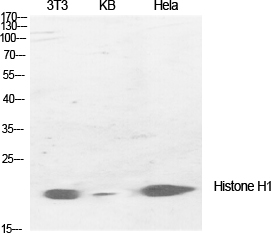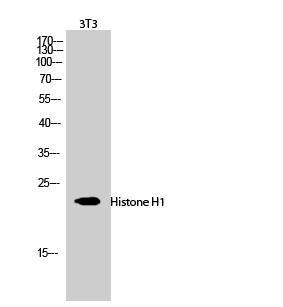

| WB | 咨询技术 | Human,Mouse,Rat |
| IF | 咨询技术 | Human,Mouse,Rat |
| IHC | 1/50-1/100 | Human,Mouse,Rat |
| ICC | 1/50-1/200 | Human,Mouse,Rat |
| FCM | 咨询技术 | Human,Mouse,Rat |
| Elisa | 1/10000 | Human,Mouse,Rat |
| Aliases | HIST1H1B; H1F5; Histone H1.5; Histone H1a; Histone H1b; Histone H1s-3; HIST1H1D; H1F3; Histone H1.3; Histone H1c; Histone H1s-2; HIST1H1E; H1F4; Histone H1.4; Histone H1b; Histone H1s-4 |
| Entrez GeneID | 3007/3008/3009 |
| WB Predicted band size | Calculated MW: 22 kDa; Observed MW: 30 kDa |
| Host/Isotype | Rabbit IgG |
| Antibody Type | Primary antibody |
| Storage | Store at 4°C short term. Aliquot and store at -20°C long term. Avoid freeze/thaw cycles. |
| Species Reactivity | Human,Mouse |
| Immunogen | The antiserum was produced against synthesized peptide derived from human Histone H1. AA range:1-50 |
| Formulation | Purified antibody in PBS with 0.05% sodium azide,0.5%BSA and 50% glycerol. |
+ +
以下是3篇关于Histone H1抗体的参考文献摘要概括:
1. **"Monoclonal antibodies specific for the core histone H1 subtypes"**
- **作者**: Parseghian, M.H. et al.
- **摘要**: 开发了针对不同Histone H1亚型的单克隆抗体,验证其特异性并应用于染色质结构研究中,揭示H1亚型在基因沉默中的作用。
2. **"Antibody-based profiling of linker histone variants in active chromatin"**
- **作者**: Brown, D.T. et al.
- **摘要**: 利用特异性抗体分析活跃染色质中的H1变异体分布,发现H1.2和H1.4在转录活跃区域的动态结合差异。
3. **"A histone H1 antibody recognizing a conserved epitope in vertebrates"**
- **作者**: Terme, J.M. et al.
- **摘要**: 报道了一种广谱识别脊椎动物H1的抗体,适用于免疫荧光和Western blot,证实H1在细胞周期中的动态定位变化。
4. **"Linker histone H1 modulates DNA methylation patterns through direct interaction with DNMT3A"**
- **作者**: Yang, S.M. et al.
- **摘要**: 使用H1抗体通过ChIP-seq技术揭示H1与DNA甲基转移酶DNMT3A的相互作用,阐明其在表观遗传调控中的新机制。
(注:以上内容为示例性概括,具体文献需通过PubMed或学术数据库检索确认)
Histone H1 antibodies are essential tools in studying the structure and function of linker histones, which play a critical role in chromatin organization. Histone H1 binds to the DNA between nucleosomes (the linker DNA), facilitating higher-order chromatin compaction and stabilizing the 30-nm fiber structure. Unlike core histones (H2A, H2B, H3. H4), H1 is more variable, with multiple subtypes (e.g., H1.0 to H1.5 in humans) exhibiting tissue-specific expression and dynamic regulation during cellular processes like differentiation or replication.
Antibodies targeting Histone H1 are widely used in techniques such as chromatin immunoprecipitation (ChIP), immunofluorescence (IF), and Western blotting to investigate its localization, post-translational modifications (e.g., phosphorylation, acetylation), and roles in gene regulation, DNA repair, and epigenetic inheritance. However, challenges exist due to sequence homology among H1 subtypes and cross-reactivity with non-target variants. Researchers must validate antibody specificity using knockout controls or recombinant proteins, as nonspecific signals can arise in certain experimental conditions.
Histone H1 dysregulation has been linked to diseases, including cancer and developmental disorders, making these antibodies valuable in both basic research and clinical diagnostics. Recent studies also explore H1's interaction with non-coding RNAs and its impact on cellular senescence, highlighting its expanding relevance in epigenetics and aging research.
×